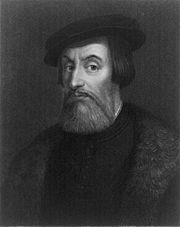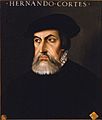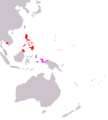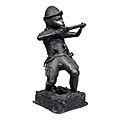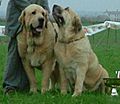Conquistador facts for kids
A Conquistador (English: Conqueror; : Conquistadores, or Conquistadors) was a Spanish soldier, explorer and adventurer. The Conquistadors invaded and conquered much of the Americas and the Philippines Islands and other islands in Asia Pacific. Many of them were hidalgos (noblemen of low category).
Their conquests brought these lands under Spanish colonial rule between the 15th and 17th centuries, starting with the 1492 settlement by Christopher Columbus in what is now the Bahamas. They created what is now called Latin America.
The first immensely successful conquistador was Hernán Cortés. Between 1520 and 1521, Cortés, along with native enemies of the Aztecs, conquered the mighty Aztec Empire. Present day Mexico came under the dominion of the Spanish Empire, as New Spain. Francisco Pizarro later found and conquered the similarly large Inca Empire.
List of Conquistadors
- Alonso Dávila (México, 1520-1533)
- Alonso del Castillo Maldonado
- Alonso de Ojeda (Venezuela, Colombia, Guyana, Aruba)
- Álvar Núñez Cabeza de Vaca (United States, 1527-1536, 1540-1542)
- Antonio de Aragón, Tucumán (Argentina)
- Cristóbal de Olid (Honduras, 1523-1524)
- Diego de Almagro (Perú, 1524-1535, Chile, 1535-1537)
- Diego de Nicuesa (Panamá, 1506-1511)
- Diego Velázquez de Cuéllar (Cuba, 1511-1519)
- Domingo Martínez de Irala
- Francisco de Montejo (Yucatán, México, 1527-1546)
- Francisco de Orellana (Amazon River, 1541-1543)
- Francisco Hernández de Córdoba (Yucatán, México, 1517)
- Francisco Pizarro (Perú, 1509-1535)
- Francisco Vázquez de Coronado (United States, 1540-1542)
- Gonzalo Jiménez de Quesada (Colombia, 1536-1537, Venezuela, 1569-1572)
- Gonzalo Pizarro (Perú, 1532-1542)
- Hernán Cortés (México, 1518-1522, Honduras, 1524, Baja California, 1532-1536)
- Hernando de Soto (United States, 1539-1542)
- Hernando Pizarro, (Perú, 1532-1560)
- Inés Suárez, (Chile, 1541)
- Juan de Esquivel, (Jamaica, 1509-1512)
- Juan de Salcedo, (North of Philippines, 1570-1576)
- Juan de Grijalva (Yucatán, México, 1518)
- Juan Pizarro, (Perú, 1532-1536)
- Juan Ponce de León (Puerto Rico, 1508, Florida, 1513 and 1521)
- Juan Rodríguez Cabrillo
- Lucas Vázquez de Ayllón (United States, 1524-1527)
- Martín de Goiti, (Manila, Philippines, 1570-1571)
- Martín de Ursúa, (Petén, Guatemala, 1696-1697)
- Miguel López de Legazpi, (Philippines, 1565-1571)
- Nicolás de Federmann (Venezuela and Colombia, 1537-1539)
- Pánfilo de Narváez (Florida, 1527-1528)
- Pedro de Alvarado (México, 1519-1521, Guatemala, 1523-1527, Perú, 1533-1535, México, 1540-1541)
- Pedro de Valdivia (Chile, 1540-1552)
- Pedro Menéndez de Avilés (Florida, 1565-1567)
- Sebastián de Belalcázar (Ecuador and Colombia, 1533-1536))
- Sebastián Vizcaíno
- Vasco Núñez de Balboa (Panamá, 1510-1519)
Images for kids
-
Hernán Cortés led the Conquest of Mexico and expanded the Spanish Empire in the Americas
-
Afonso de Albuquerque expanded the Portuguese Empire across the Indian Ocean
-
The surrender of Granada in 1492. The last Moorish sultan of Granada, Muhammad XII, before Ferdinand and Isabella.
-
Christopher Columbus and his Spanish crew making their first landfall in the Americas in 1492
-
Conquistadors praying before a battle at Tenochtitlan
-
Francisco Pizarro meets with the Inca emperor Atahualpa, 1532
-
Hernán Cortés and his counsellor, the Indian woman La Malinche meet Moctezuma II in Tenochtitlan, 8 November 1519. Facsimile (c. 1890) of Lienzo de Tlaxcala.
-
Vasco Núñez de Balboa and spanish conquistadors claiming the Pacific Ocean for Spain in 1513.
-
Diego de Almagro led the first Spanish expedition south of Peru into Chile 1535–37.
-
Francisco de Orellana and his men became the first to travel the entire length of the Amazon River in 1541–1542
-
Gonzalo Jiménez de Quesada, conquistador of the New Kingdom of Granada.
-
The conquistador Juan Ponce de León (Santervás de Campos, Valladolid, Spain). He was the first European to arrive at the current U.S. and led the first European expedition to Florida, which he named.
-
Monument to Cabeza de Vaca in Houston, Texas.
-
Route of Narváez expedition (until November 1528), and a reconstruction of Cabeza de Vaca's later wanderings
-
The Coronado expedition, 1540–1542
-
A map showing the de Soto route through the Southeast, 1539–1542
-
Statue of Miguel López de Legazpi, Cebu City, Philippines
-
1630 map of the Portuguese fort and the city of Malacca
-
Forte de Nossa Senhora da Conceição de Ormuz (Fort of Our Lady of the Conception), the Portuguese Castle on Hormuz Island (Iran)
-
Nagasaki in Japan was founded in 1570 by Portuguese explorers
-
Portuguese North America (in present-day Canada); Vaz Dourado, c.1576.
-
The Portuguese victory at the Second Battle of Guararapes, ended Dutch presence in Brazil.
-
António Raposo Tavares, a bandeirante, led in 1648–1652 the largest continental expedition made in the Americas until then, from São Paulo to the east, near the Andes (via Mato Grosso, the Paraguay River, the Grande River, the Mamoré River, and the Madeira River), and to the Amazon River and the Atlantic
-
Battle of Cartagena de Indias, March–May 1741, during this battle the Spanish Empire defeated a British fleet of over 30,000 professional soldiers, 51 warships and 135 transport ships counting the Spanish army only less than 2400 professional soldiers, 600 natives and 6 ships.
-
Álvaro de Bazán, Spanish admiral famous for never having lost a battle.
-
The combined Spanish and Portuguese empires during the Iberian Union (1580–1640)
-
Map of the Island of California, circa 1650; restored.
-
1541 founding of Santiago de Chile
-
Bronze equestrian statue of Francisco Pizarro in Trujillo, Spain
-
Philip II of Spain (1527–1598).
-
Alonso de Ovalle's 1646 engraving of the conquistadors García Hurtado de Mendoza, Pedro de Villagra and Rodrigo de Quiroga
-
A group of 16th century conquistadors that participated in the Spanish conquest of Peru (second expedition) along with their leader, Francisco Pizarro.
-
Ephemeris by Abraham Zacuto in Almanach Perpetuum, 1496
-
A Portuguese caravel
-
Portolan of Angelino Dulcert (1339) showing Lanzarote island
-
Pre-mercator navigation chart of the Coast of Africa (1571), by Fernão Vaz Dourado (Torre do Tombo, Lisbon)
-
Iberian Union (1581–1640)
-
The Manila-Acapulco trade route started in 1568 and Spanish treasure fleets (white) and its eastwards rivals, the Portuguese India Armadas routes of 1498–1640 (blue)
-
Gonzalo Guerrero, a shipwrecked Spanish mariner who married a Maya woman and later fought with the Mayas against the conquistadors
-
Conquest of the Canary Islands (1402–1496)
-
Bandeirantes were crucial in Portuguese exploration, colonization, and pacification of the Brazilian interior.
See also
 In Spanish: Conquistadores españoles para niños
In Spanish: Conquistadores españoles para niños


